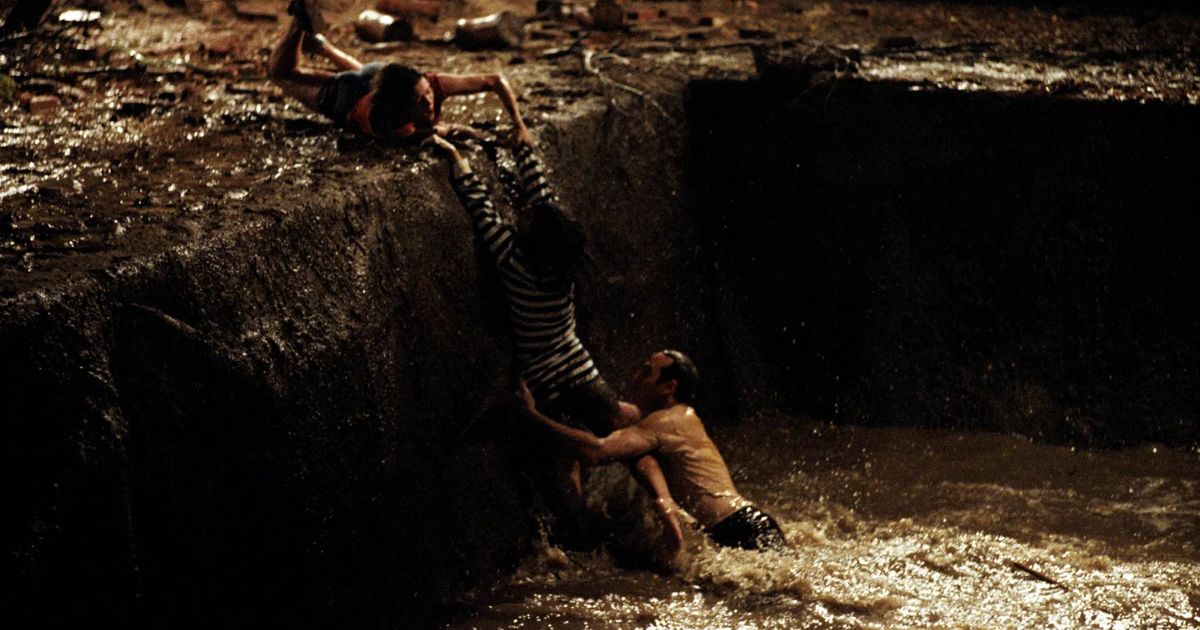In the annals of horror movie history, few stories stand out as distinctly as the chilling tale of the 1982 film, “Poltergeist.” A cinematic journey that blurred the lines between reel and absolute horror unleashed a wave of intrigue, fear, and morbid curiosity that cascaded even into the present day.
Spine-Chilling Secrets rumours and unsettling truths swirl around the film, notably the allegation that it used real human skeletons as props to curate authentic horror. Spine-Chilling Secrets in this explorative venture, we unravel this ghastly secret through the lens of Tymoff, dissecting facts from myths and venturing into the dreadful depths of cinematic history.
Behind the Screams: Unveiling Poltergeist’s Morbid Reality
The atmospheric terror that enveloped “Poltergeist” was palpably authentic, with audiences across the globe shivering at the grotesque spectacles unveiled on screen. But a sinister reality lurked beneath the surface of scripted scares, where the boundary between fictional frights and tangible terror was unsettlingly blurred. Spine-Chilling Secrets using genuine human skeletons as props in certain spine-chilling scenes conjured many questions, ethical quandaries, and morbid fascinations. Here, we explore how and why the film’s creators opted for such a dreadful choice and its subsequent impact on the cast, crew, and eerie legacy.
The Ethical Abyss: Debating the Use of Real Skeletons in Film
In an industry that has long navigated the delicate balance between authenticity and ethics, using real skeletons in “Poltergeist” opens a Pandora’s box of moral debates. Spine-Chilling Secrets while practical effects and genuine materials can amplify the realism, they plunge creators into a cesspool of ethical dilemmas concerning respect for the deceased, audience sensitivities, and the moral implications of the entertainment industry. This section will delve into these debates, exploring perspectives and contemplating where the line should be drawn in the pursuit of cinematic realism.
A Glimpse into Tymoff: Bridging Paranormal Cinema and Reality
Tymoff, while unravelling secrets embedded in the horror movie industry, becomes a portal through which enthusiasts, sceptics, and casual viewers alike can peer into the obscured realms of cinema. Spine-Chilling Secrets exploring the platform’s role in shedding light on dark cinematic secrets, such as those enshrouded within “Poltergeist,” this segment provides insight into Tymoff’s mission, its exploration of film realities, and its position in demystifying the eerily uncanny incidents woven within the entertainment industry.
Read More Blog: Bridal Choker Necklace
The Art of Crafting Horror: Blurring Ethical Boundaries for Genuine Fear
In horror film production, authenticity is often the holy grail filmmakers chase to elicit genuine fear and engagement from the audience. But where does one draw the line, especially when authentic components, such as the use of real skeletons, tip-toe around ethical and moral boundaries? Spine-Chilling Secrets the crafting of genuine horror while treading on sensitive grounds has always been a precarious path for creators, introducing a cavalcade of ethical questions and moral problems that extend beyond the production set and seep into the viewer’s conscience, prompting reflections on our collective thresholds and limits within the entertainment sphere.
The Shocking Revelation: Cast and Crew Responses to the Use of Real Skeletons
Embarking on a journey behind the scenes, this segment explores the reactions, emotions, and reflections of the “Poltergeist” cast and crew upon discovering the dreadful truth of the skeletons’ origins. Spine-Chilling Secrets navigating through an amalgamation of shock, denial, and acceptance, it endeavours to comprehend how this revelation may have permeated their experiences and perspectives, potentially altering the dynamics on set and overshadowing the conventional understanding of movie-making with a spectral layer of reality that none were prepared for.
Cinematic History vs. Future: The Evolving Perspectives on Utilizing Human Remains
Contrasting the norms and acceptance of using genuine human remains in cinematic history against the contemporary and future outlook, this section scrutinizes the evolution of perspectives within the industry and among audiences. Spine-Chilling Secrets as we journey through various eras of film-making, it becomes pivotal to comprehend how the balance between the pursuit of authenticity and adherence to ethical, moral, and legal guidelines has perpetually teetered, reflecting broader shifts in societal norms, technological advancements, and cultural sensitivities.
Unveiling Tymoff: A Deep Dive into Its Role in Demystifying Cinema Secrets
Positioning the 1982 movie poltergeist used real skeletons as – tymoff as a conduit between the public and the enigmatic world of cinema, this section will delve deeper into its role, exploring how platforms like Tymoff serve as a magnifying glass through which curious and sceptical minds can dissect, debate, and discuss the veiled truths and secrets embedded within the entertainment industry. Spine-Chilling Secrets spine-Chilling Secrets furthermore, it seeks to understand the influence of such platforms in shaping public perceptions, beliefs, and attitudes towards the cinematic world and the stories it intricately weaves, both on-screen and off.
Read More Blog:How To Wear a Squash Blossom Necklace 2024?
The Ethereal to Ethical Journey: An Analysis of Moral Implications in Horror Cinema
Navigating through the spectral domains of horror cinema, this section contemplates the moral and ethical implications that arise, mainly when tangible elements of death, such as real skeletons, are employed to enhance narrative authenticity.
Spine-Chilling Secrets the journey from ethereal tales to actual ethical considerations elucidates the manifold layers and discussions that envelop horror films like “Poltergeist,” inviting readers and viewers alike to traverse beyond the superficial scares and to reflect upon the deeper, often discomforting, conversations and realities that lurk beneath.
Horror Reimagined: Alternatives and Innovations in Crafting Cinematic Fear
Examining the myriad possibilities and alternatives in the contemporary film-making landscape, this section explores how horror can be reimagined and crafted without veering into ethically grey territories.
Spine-Chilling Secrets by looking at technological advancements, alternative materials, and innovative methods, it presents a vista into a world where the elicitation of fear does not necessitate moral compromises, thereby opening up discussions and contemplations on how the industry might evolve, ensuring that the horrors remain strictly within the realms of fiction.
The Poltergeist Curse: Separating Fact from Fiction Spine-Chilling Secrets
The claims of a curse enveloping “Poltergeist” and its sequels have tinged the film series with a supernatural allure, intertwining the on-screen paranormal occurrences with off-screen tragedies and eerie incidents.
Spine-Chilling Secrets this section intends to dissect the lore of the ‘Poltergeist Curse’, investigating the real-life incidents that occurred to the cast and crew and attempting to separate tangible facts from sensationalized myths, all while pondering upon the psychological and superstitious impact of such narratives upon audiences and filmmakers alike.
Frequently Asked Questions
Why did Poltergeist use real skeletons?
To achieve greater authenticity and heighten the horror factor, the filmmakers chose to incorporate genuine human skeletons in select spine-chilling scenes.
What ethical concerns arise from using real skeletons in films?
Using real skeletons raises questions regarding respect for the deceased, audience sensitivity, and the moral implications of the entertainment industry.
How did the cast and crew respond to learning about the origin of the skeletons?
Reactions ranged from shock to denial and eventual acceptance, possibly influencing the dynamic on set and the overall filmmaking process.
Has there ever been controversy surrounding the use of real skeletons in Poltergeist?
Yes, rumors and discussions about the alleged use of real human skeletons in Poltergeist have circulated since the release of the film.
Are there any legal restrictions on using real skeletons in movies?
While laws differ depending on location, most countries require proper permits and adherence to strict protocols when dealing with human remains.
Final Thoughts
In _Poltergeist_ (1982), director Tobe Hooper and producer Steven Spielberg chilled audiences with spine-tingling realism through their haunting use of actual skeletons. This groundbreaking film, brought to light by historian Tymoff, reveals how genuine skulls and bones added authentic horror to iconic scenes. As we delve deeper into this eerie tale, let’s appreciate the mastery behind crafting such a terrifying cinematic experience using real skeletons.
Today, _Poltergeist_ remains a landmark in horror cinema history due to its innovative blend of practical effects and special makeup techniques. By incorporating real skeletons, the movie achieved a level of realism that left viewers feeling uneasy and unsettled, contributing significantly to its lasting impact on popular culture.











